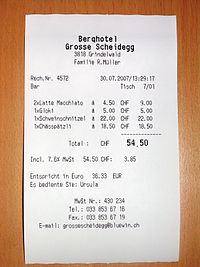Receipt: Difference between revisions
Enthusiast01 (talk | contribs) |
Enthusiast01 (talk | contribs) No edit summary |
||
| Line 1: | Line 1: | ||
:''See also [[Voucher]] |
:''See also [[Voucher]] |
||
A '''receipt''' is a written acknowledgment that a specified article or sum of money has been received. A receipt records the purchase of goods or service. It is not the same as an [[invoice]].<ref name="autogenerated1">{{cite web|url=http://dictionary.law.com/Default.aspx?selected=1740 |title=Legal Dictionary | Law.com |publisher=Dictionary.law.com |date=2010-12-09 |accessdate=2013-09-03}}</ref> |
A '''receipt''' is a written acknowledgment that a specified article or sum of money has been received. A receipt records the purchase of goods or service. It is not the same as an [[invoice]].<ref name="autogenerated1">{{cite web|url=http://dictionary.law.com/Default.aspx?selected=1740 |title=Legal Dictionary | Law.com |publisher=Dictionary.law.com |date=2010-12-09 |accessdate=2013-09-03}}</ref> In some situations it is obligatory for a business to provide a receipt to a customer confirming the details of a transaction. However, there is usually no set form for a receipt, such as a requirement that it be machine generated. Many point-of-sale terminals or cash registers automatically produce receipts. Receipts may also be generated by accounting systems. |
||
==Printed== |
==Printed== |
||
Revision as of 03:24, 7 June 2014
- See also Voucher
A receipt is a written acknowledgment that a specified article or sum of money has been received. A receipt records the purchase of goods or service. It is not the same as an invoice.[1] In some situations it is obligatory for a business to provide a receipt to a customer confirming the details of a transaction. However, there is usually no set form for a receipt, such as a requirement that it be machine generated. Many point-of-sale terminals or cash registers automatically produce receipts. Receipts may also be generated by accounting systems.
Printed

In English speaking countries, the term most frequently applies to the printed record given to a consumer at the point of sale which lists the purchases made and the prices including tax, discounts and other adjustments, the amount paid, and the method of payment. The receipt may also include messages from the retailer, warranty or return details, special offers, advertisements or coupons. Receipts may also be provided for non-retail operations such as banking transactions. A receipt is a legal document.[1] In many countries it is legal obligation for retailers to provide a receipt to a customer which shows the details of a transaction and the store and other information, so that the tax authority can check that sales are not being hidden.[2]
Thermal paper
A receipt may be printed using thermal printing on narrow rolls of thermal paper. Multi-colored thermal printing technology can print double-sided receipts.
Gift receipts
Receipts are usually required to be produced by a customer seeking to exchange or return merchandise. This may create problems when an item is intended to be given as a gift. Some retailers provide to the customer on request an additional receipt, often called a "gift receipt", which is a copy of the true receipt except that it omits some information, such as the price that was paid for an item. The gift receipt would be given to the recipient of the gift, who may bring the gift receipt with the item to the store if there is a need to exchange the item, or if there is any other query.
Barcodes
Receipts may include a barcode that enables a salesperson to scan the code and quickly bring up the details of the original transaction, for example if a customer seeks to return or exchange goods. Some retailers' point-of-sale systems allow the salesperson to see a complete record of the customer's buying history, including information about other store locations the customer has visited, what they purchased or returned, and total accumulated spending, besides other information.
Non-printed
Hand-written or hand-completed receipts are more often used for infrequent or irregular transactions, or for transactions conducted in the absence of a terminal, cash register or point of sale: for example, as provided by a landlord to a tenant to record the receipt of rent.
Related industries
Organizing receipts and similar financial documents is a multi-million dollar industry in the United States. Consumers can use desktop and online software to organize electronic receipts; sometimes, receipts are sent digitally from point of sale devices to consumers. The growing trend of digital receipts has led to the launch of new businesses focused on digital receipt management.
See also
- Cash register
- Document automation in supply chain management & logistics
- Invoice
- Point of sales
- Proof of purchase
- Return receipt
References
- ^ a b "Legal Dictionary | Law.com". Dictionary.law.com. 2010-12-09. Retrieved 2013-09-03.
- ^ "Recordkeeping for Individuals". Irs.gov. Retrieved 2013-09-03.
